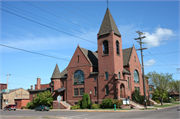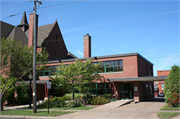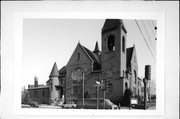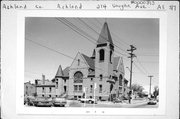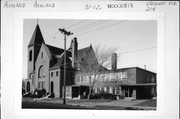Property Record
214 VAUGHN AVE
Architecture and History Inventory
| Historic Name: | FIRST PRESBYTERIAN CHURCH |
|---|---|
| Other Name: | |
| Contributing: | |
| Reference Number: | 813 |
| Location (Address): | 214 VAUGHN AVE |
|---|---|
| County: | Ashland |
| City: | Ashland |
| Township/Village: | |
| Unincorporated Community: | |
| Town: | |
| Range: | |
| Direction: | |
| Section: | |
| Quarter Section: | |
| Quarter/Quarter Section: |
| Year Built: | 1897 |
|---|---|
| Additions: | |
| Survey Date: | 19822016 |
| Historic Use: | church |
| Architectural Style: | Romanesque Revival |
| Structural System: | |
| Wall Material: | Brick |
| Architect: | WARREN H HAYES |
| Other Buildings On Site: | |
| Demolished?: | No |
| Demolished Date: |
| National/State Register Listing Name: | Not listed |
|---|---|
| National Register Listing Date: | |
| State Register Listing Date: |
| Additional Information: | 1982 DESCRIPTION: This is Ashland's best example of Richardsonian Romanesque-style religious architecture. The smooth red brick and rock-faced brownstone church was built in 1897 after a design by Minneapolis architect Warren H. Hayes. All of the Richardsonian Romanesque featues are present, notably the brownstone voussoirs that define the many variously-sized arched window, door, and tower openings, the tall tower, and the circular tower. The church consists of a compact L-plan of intersecting tall gables and at the rear a hip roof chapel and offices extend on the northwest side. Here there is a squat circular turret with a tent roof pierced by rectangular windows. The gable at this side is pierced by a large arched window with the original stained glass; this arrangement is repeated on the southeast side from which extends a twenty-five year old addition. At the prominent corner, a square tower/belfry extends upwards of three stories and is capped by a pyramidal roof. Below, there is a large opening on both sides. At the base where the datestone is located is a large brownstone Richardsonian arch. The whole building rests on a brownstone foundation. The interior is in superb condition with all of its original oak woodwork. The congregation seating area is arranged on a diagonal that puts the pews in a radiating pattern around the centrally located altar; there is a similarly shaped protruding balcony above which also faces northeast toward the altar. The beautiful and original stained glass windows for the Vaughn and Bardon families are intact. Tall oak and glass doors separate the seating area from an adjacent chapel. SIGNIFICANCE: Although church buildings are normally exempt from the NRHP, the Presbyterian-Congregational Church in Ashland is architecturally significant as a local example of Richardsonian Romanesque architecture that is unsurpassed in Ashland. The building is significant as well for its association with the reputable Minneapolis church architect Warren H. Hayes, who built similar churches in Minneapolis, Peoria, and Salt Lake City. 2017 survey report information: Located at the corner of Vaughn Avenue and Third Street West, this Richardsonian Romanesque-style church rises from a brownstone foundation and is clad with brick; additional brownstone trims doors and windows throughout. The church’s core is topped with a pyramidal hipped roof from which gabled wings extend to the south and west, while a three(+) story bell tower with an open belfry anchors the building at its immediate corner. Each of the gabled endwalls carries a large focal window arrangement consisting of a pair of rectangular openings topped with a round-arched window, all of which display stained glass. Staircases provide entry to a pair of round-arched entrances along Third Street West, while an additional entrance is located along Vaughn Avenue, adjacent to a two-story, round tower. A two-story, flat-roofed and brick-clad classroom wing extends from the west elevation of the church. A large expanse of fenestration lines the wing along its south elevation; the original, multi-light, steel-frame windows of which have been replaced since 2001. Built in 1897, the First Presbyterian Church was designed by Minneapolis architect Warren H. Hayes who was born in New York and graduated from Cornell University in 1871. Ten years later he would move to Minneapolis, where he would specialize in church design. He is noted as the creator of the diagonal auditorium, the plan of which was utilized for the subject church. Organized on 20 July 1880 with less than twenty charter members, the congregation’s first church was located at Ellis Avenue and Third Street West (no longer extant), a facility that had been vacated by the Methodists. Although plans for a new church had begun as early as 1891, financial matters delayed its construction until 1897. At the time of the church’s construction, the city was without a suitable hall for public assemblies and it was reportedly agreed that that church auditorium be made available for public events such as concerts and lectures. In 1929, when Bethel Presbyterian Church closed, First Presbyterian’s membership increased. In 1943, Ashland’s First Presbyterian Church and First Congregational Church (est. 1887) became federated, which continued into the late 1960s. At that time, the separate governing bodies were eliminated and a unified board was put in place. In 1957-58, an educational building was added to the east side of the church. The church continues to serve the congregation of the United Presbyterian Congregational Church. |
|---|---|
| Bibliographic References: | Eckert, Kathryn. Sandstone Buildings in the Lake Superior Region. Detroit: Wayne State University Press, 2000. 2017 citations for 2017 material below: Charter membership is noted as nineteen in Smith and Goc, eds., Looking Backward, Moving Forward, 97-98, and in Manthei, Ashland: Oh How You’ve Changed, Vol. 2, 6-7; however, The Ashland Daily Press Annual, 1891-92, 23, indicates a number of eighteen; Henry F. and Elsie T. Withey, Biographical Dictionary of American Architects [Deceased] (Los Angeles: Hennessey and Ingalls, Inc., 1970), 274. |
| Wisconsin Architecture and History Inventory, State Historic Preservation Office, Wisconsin Historical Society, Madison, Wisconsin |

